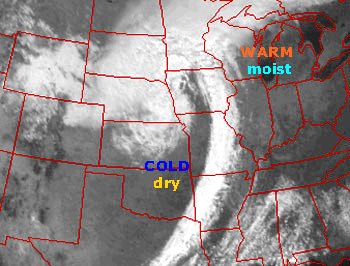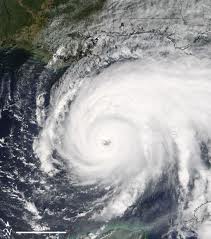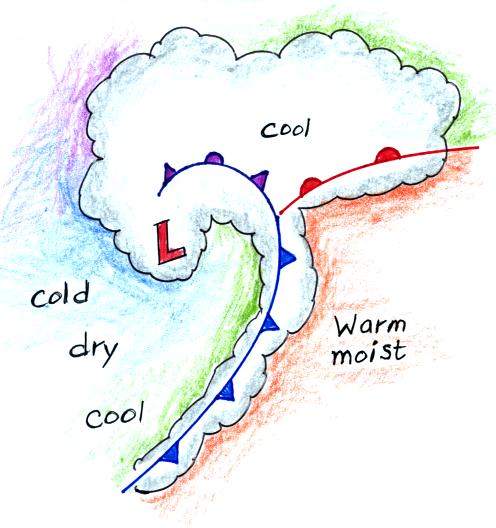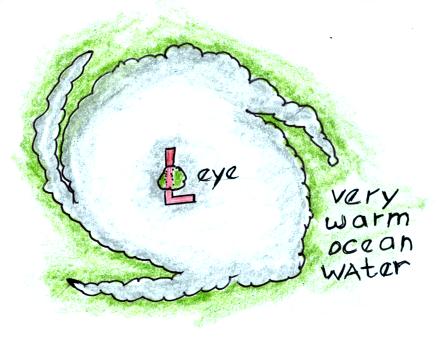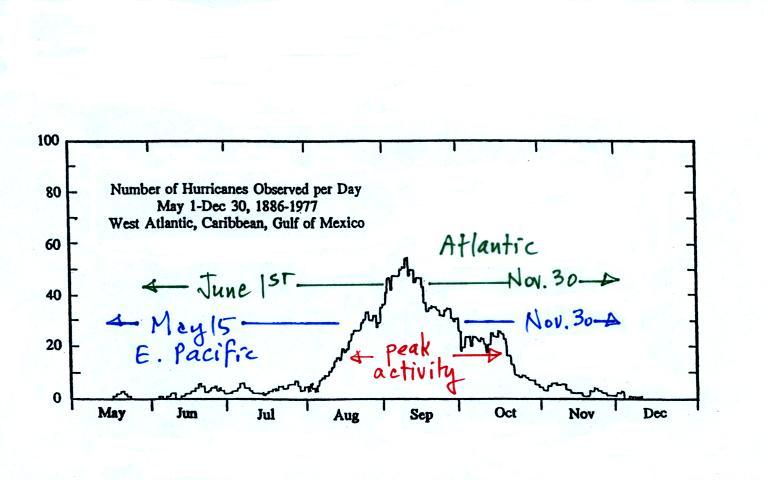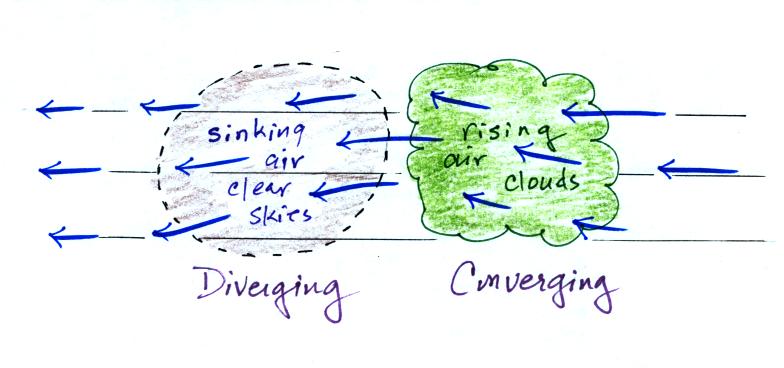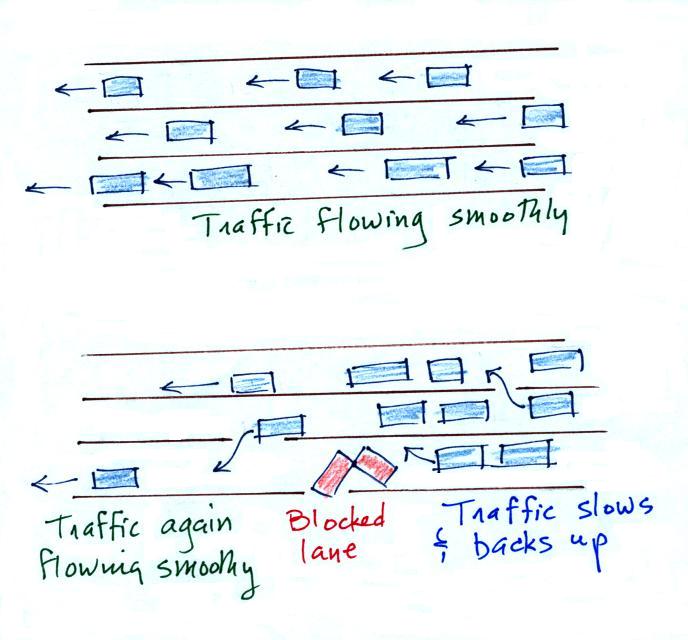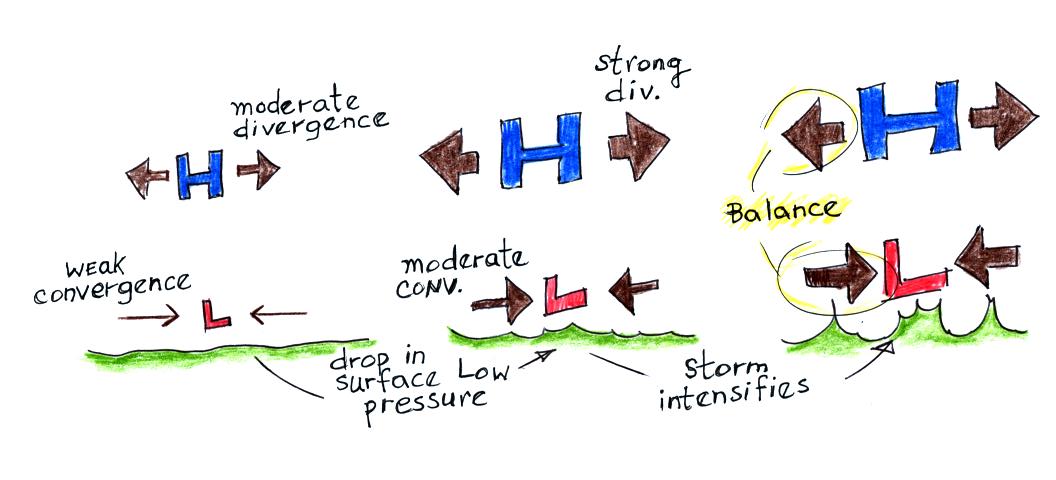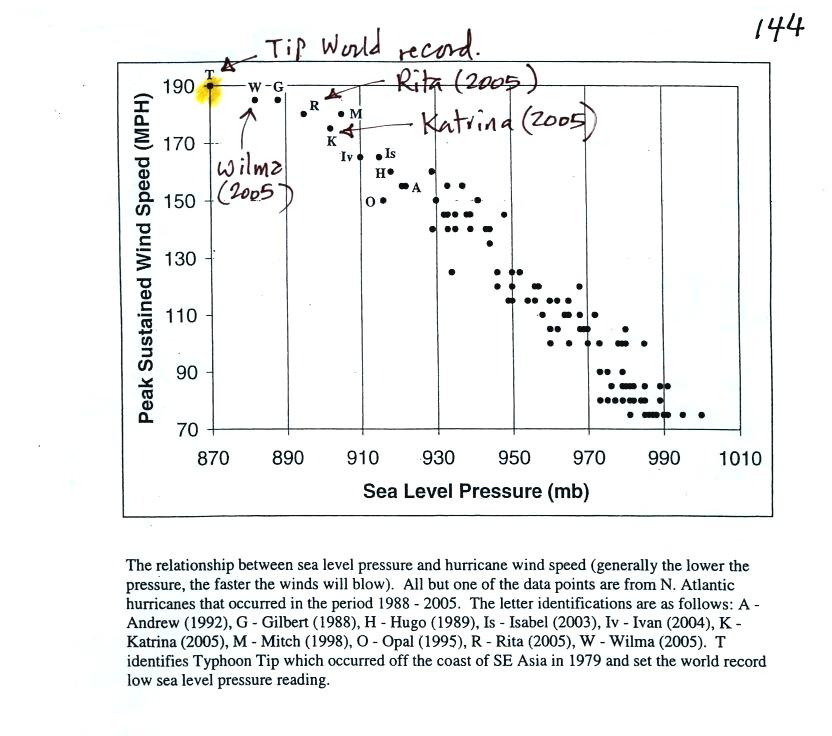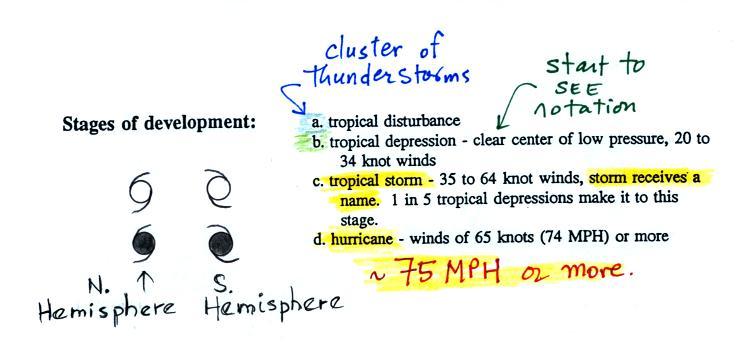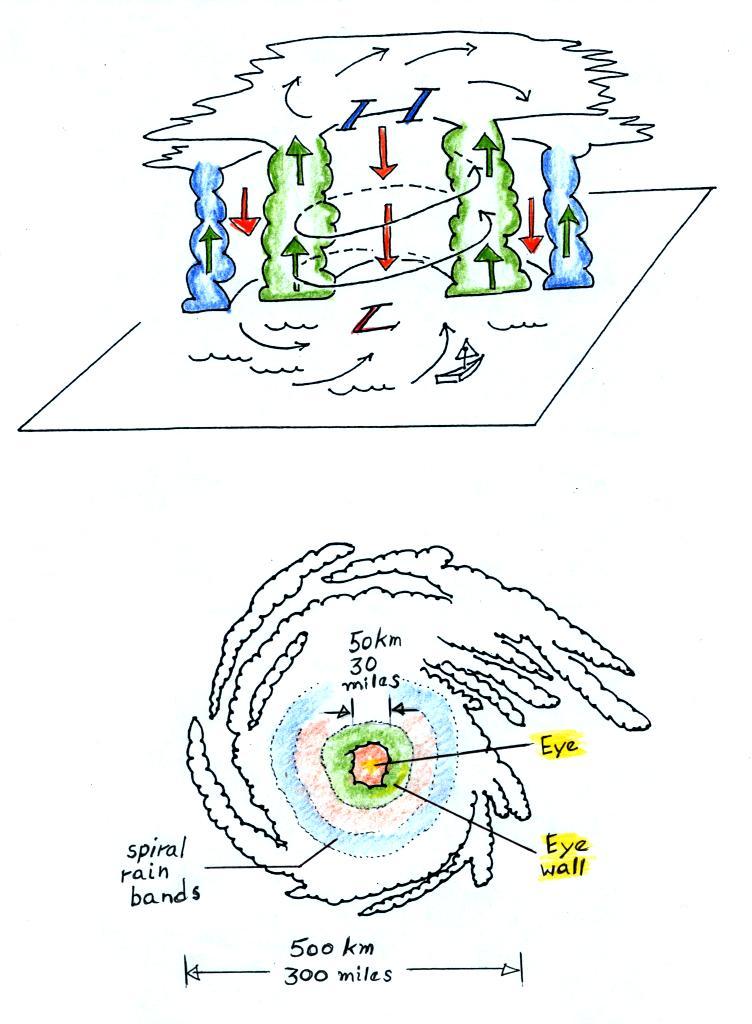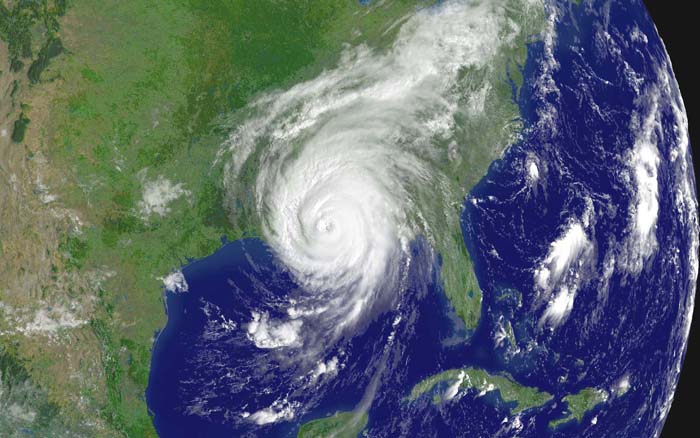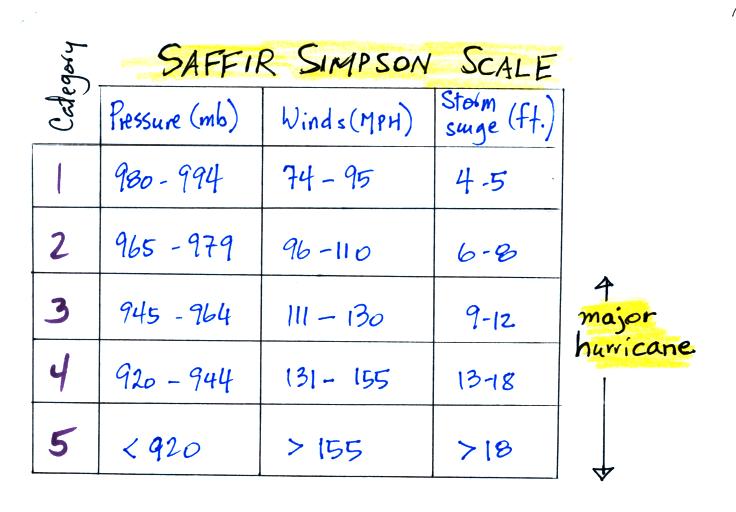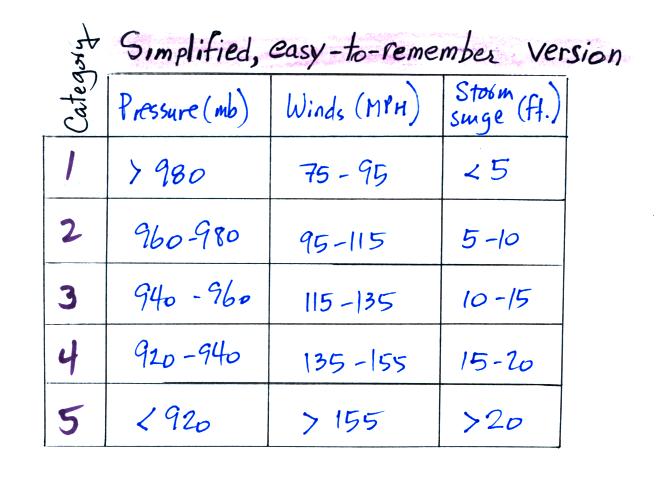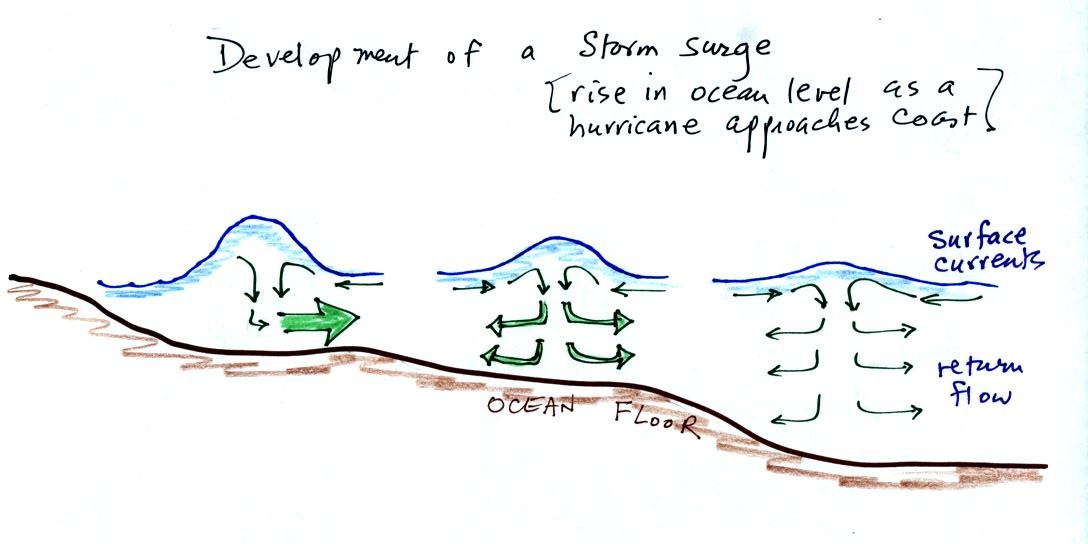Friday Apr. 26, 2013
Michael Buble
& Naturally 7 sing in the NYC Subway (4:00), Naturally 7 in
the Paris Subway (5:12)
Hurricanes will be the final topic
that we cover this semester. 5 questions on the Final Exam
will come directly from this list
of hurricane questions. You'll find answers to all the
questions in the notes below.
On average, hurricanes kill 20 people per year in the United
States and cause about $5 billion of damage. As the table
below indicates though there are exceptional years (such as 2005)
where the death and damage totals greatly exceed these average
values (data are from www.economics.noaa.gov)
Year
|
Deaths
|
Total
Damage
(billion $ ))
|
2000
|
0
|
<
1
|
2001
|
24
|
6.5
B
|
2002
|
51
|
1.7
B
|
2003
|
14
|
2.3
B
|
2004
|
34
|
22.9
B
|
2005
|
1016
|
107.5
B
|
2006
|
0
|
<
1
|
2007
|
1
|
<
1
|
2008
|
11
|
7.9
B
|
2009
|
2
|
<
1
|
2010
|
0
|
<
1
|
2005 was, of course, the year
hurricane Katrina hit New Orleans. Three of the ten
strongest hurricanes ever observed in the N. Atlantic occurred
in 2005 (Wilma was the strongest and the new record holder, Rita
was 4th and Katrina 6th strongest). The deadliest
hurricane in US history is the 1900 Galveston hurricane which
caused 6000 - 12,000 deaths. The Great Hurricane of 1780
killed over 20,000 people in the Lesser Antilles. Historic
rainfall amounts (75 inches perhaps in some locations) and
flooding associated with Hurricane Mitch killed over 19,000
people in Honduras, Guatemala, and Nicaragua in 1998.
A good place to begin is to compare hurricanes (tropical
cyclones) with middle latitude storms (extratropical
cyclones). These are the two largest types of storm systems
found on the earth.
Satellite photographs and sketches of the two types of storm
system are shown below.
Next we'll list some of the similarities (first table
below) and differences (second table; the left column applies to
middle latitude storms, the right most column to hurricanes)
between these storms.
Similarities
|
both types of storms
have low pressure centers
(the term cyclone refers to winds blowing around
low pressure) |
upper level divergence
is what causes both types of storms to intensify
(intensification means the surface low pressure
gets even lower)
|
Differences
(the order may differ from that given in class)
|
1. Middle latitude
storms are bigger,
perhaps 1000 miles in diameter (half the US)
|
1. Hurricanes are
smaller,
100s of miles in diameter (fill the Gulf of Mexico)
|
2. Formation can occur
over land or water
|
2. Can only form over
warm ocean water
weaken rapidly when they move over land or cold water
|
3. Form at middle (30o
to 60o) latitudes
|
3. Form in the sub
tropics, 5o to 20o latitude
|
4. Prevailing westerlies
move these storms
from west to east
|
4. Trade winds move
hurricanes
from east to west
|
5. Storm season: winter
to early spring
|
5. Storm season: late
summer to fall
(when ocean water is warmest)
|
6. Air masses of
different temperatures collide along fronts
|
6. Single warm moist air
mass
|
7. All types of
precipitation: rain, snow, sleet freezing rain
|
7. Mostly just lots (a
foot or more) of rain
|
8. Only an occasional
storm gets a name
("The
Perfect
Storm", "Storm
of the Century", etc.)
|
8. Tropical storms &
hurricanes gets names
|
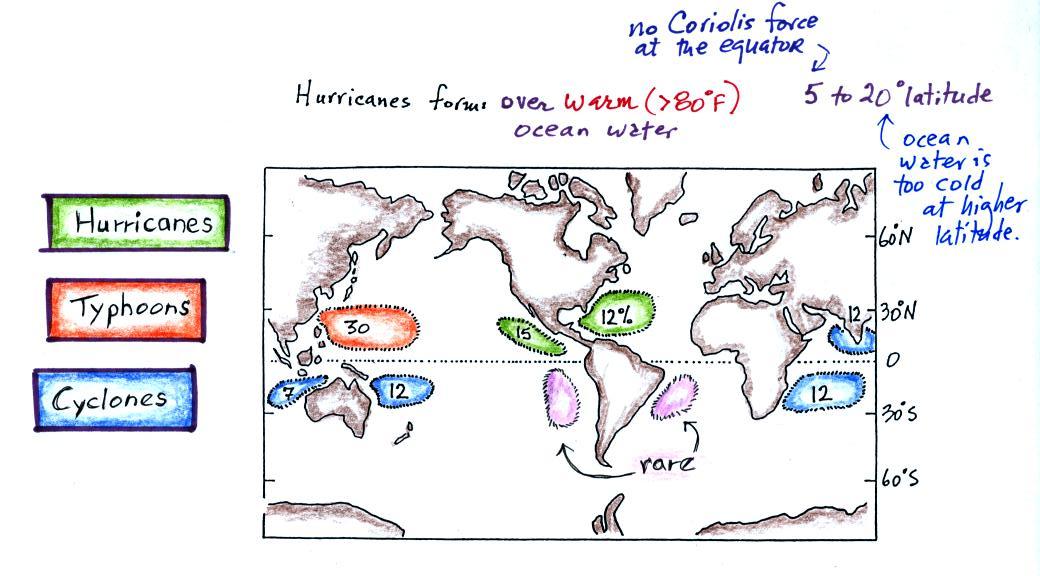
The figure above shows the relative frequency of
tropical cyclone development in different parts of the
world. The name hurricane,
cyclone, and typhoon all refer to the same type of storm (tropical
cyclone is a generic name that can be used anywhere). In
most years the ocean off the coast of SE Asia is the world's most
active hurricane zone. Hurricanes are very rare
off the east and west coasts of South America.
Hurricanes form between 5 and 20 degrees latitude,
over warm ocean water, north and south of the equator.
The warm layer of water must be fairly deep to contain enough
energy to fuel a hurricane and so that turbulence and mixing
don't bring cold water up to the ocean surface. The
atmosphere must be unstable so that thunderstorms can
develop. Hurricanes will only form when there is very
little or no vertical wind shear (changing wind direction or
speed with altitude). Hurricanes don't form at the
equator because there is no Coriolis force there (the Coriolis
force is what gives hurricanes their spin and it causes
hurricanes to spin in opposite directions in the northern and
southern hemispheres).
Note that more tropical cyclones form off the west coast of the
US than off the east coast. The west coast hurricanes don't
generally get much attention, because they move away from the
coast and usually don't present a threat to the US (except
occasionally to the state of Hawaii). The moisture from
these storms will sometimes be pulled up into the southwestern US
where it can lead to heavy rain and flooding.
Hurricane season in the Atlantic officially runs from June 1
through to November 30. The peak of hurricane season is in
September. In 2005, an unusually active hurricane season in
the Atlantic, hurricanes continued through December and even into
January 2006. Hurricane season in the Pacific begins two
weeks earlier on May 15 and runs through Nov. 30.
Some
kind
of
meteorological
process
that
produces
low
level
convergence
is
needed
to initiate a hurricane. One possibility, and the one that
fuels most of the strong N. Atlantic hurricanes, is an "easterly
wave." This is just a "wiggle" in the wind flow pattern.
Here's a little bit better sketch than the one on p. 142 in
the photocopied ClassNotes.
In some ways winds blowing through an easterly wave resembles
traffic on a multi-lane highway. Traffic will slow down
and start to bunch up as it approaches an obstruction.
This is like the convergence that occurs when air flows into an
easterly wave. Once through the "bottleneck" traffic will
begin to flow more freely.
Easterly waves often form over Africa or just off the African
coast and then travel toward the west across the N.
Atlantic. Winds converge as they approach the wave and
then diverge once they are past it . The convergence will
cause air to rise and thunderstorms to begin to develop.
| Normal hurricane
activity in the Pacific |
Normal hurricane
activity in the Atlantic |
16
tropical storms per year
8 reach hurricane strength
0 hit the US coastline |
10
tropical storms per year
6 reach hurricane strength
2 hit the US coastline |
In an average year, in the N. Atlantic, there will be
10 named storms (tropical storms or hurricanes) that develop
during hurricane season. 2005 was, if you remember, a
very unusual year. There were 28 named storms in the N.
Atlantic in 2005. That beat the previous record of 21 names
storms that had been set in 1933. Of the 28 named storms, 15
developed into hurricanes.
This is a reasonably important figure (I showed it in class
while a video was playing; we'll come back to it again next
Monday). It tries to explain how a cluster of
thunderstorms can organize and intensify into a hurricane.
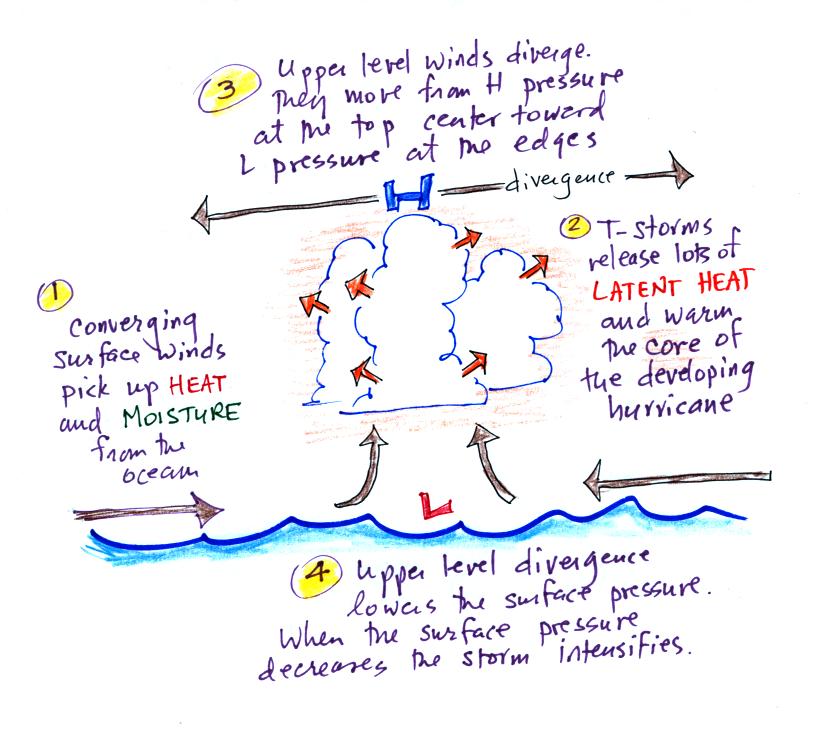
1. Converging surface
winds pick up heat and moisture from the ocean. These are
the two mains sources of energy for the hurricane.
2. Rising air expands, cools, and thunderstorm
clouds form. The release of latent heat during
condensation warms the atmosphere. The core of a hurricane
is warmer than the air around it.
3. Pressure decreases more slowly with increasing
altitude in the warm core of the hurricane. The result is
that pressure at the top center of the hurricane is higher than
the pressure at the top edges of the hurricane (pressure at the
top center is still lower than the pressure at the bottom center
of the hurricane). Upper levels winds diverge and spiral
outward from the top center of the hurricane (you can sometimes
see this on satellite photographs of hurricanes).
4. The upper level divergence will cause the
surface pressure at the center of the hurricane to
decrease. The speed of the converging surface winds
increases and the storm intensifies. The converging winds
pick up additional heat and moisture which warms the core of the
hurricane even more. The upper level high pressure and the
upper level divergence increase. The increased divergence
lowers the surface pressure even more.
Here's another view of hurricane
development and intensification
In the figure at left the moderate divergence found at upper
levels is stronger than the weak surface convergence.
Divergence is removing more air than is being added by surface
convergence. The surface low pressure will decrease.
The decrease in surface pressure will cause the converging surface
winds to blow faster.
In the middle picture, the surface low pressure is lower, the
surface convergence has strengthened to moderate levels. The
upper level divergence has also strengthened. The upper
level divergence is still stronger than the surface convergence so
the surface low pressure will decrease even more and the storm
will intensify.
In the right figure the surface low pressure has decreased
enough that the strong surface convergence now balances the strong
upper level divergence. The storm won't strengthen any more.
Generally speaking the lower the surface pressure at the center
of a hurricane the stronger the storm and the faster the surface
winds will blow.
This figure tries to show the relationship between surface
pressure and surface wind speed. The world
record low sea level pressure reading, 870 mb, was set by Typooon
Tip off the SE Asia coast in 1979. Sustained winds in
that storm were 190 MPH. Three 2005 Atlantic hurricanes:
Wilma, Rita, and Katrina had pressures in the 880 mb to 900 mb
range and winds ranging from 170 to 190 MPH.
A tropical disturbance is just a localized cluster of
thunderstorms that a meterologist might see on a satellite
photograph. But this would merit observation because of the
potential for further development. Signs of rotation would
be evidence of organization and the developing storm would be
called a tropical depression.
In order to be called a tropical storm the storm must strenthen
a little more, and winds must increase to 35 knots. The
storm receives a name at this point. Finally when winds
exceed 75 MPH (easier to remember than 65 knots or 74 MPH) the
storm becomes a hurricane. You don't need to remember all
these names, just try to remember the information highlighted
above.
A crossectional view of a mature hurricane (top) and a picture
like you might see on a satellite photograph (below).
Sinking air in the very center of a hurricane produces the
clear skies of the eye, a hurricane's most distinctive
feature. The eye is typically a few 10s of miles across,
though it may only be a few miles across in the strongest
hurricanes. Generally speaking the smaller the eye, the
stronger the storm.
A ring of strong thunderstorms, the eye wall, surrounds the
eye. This is where the hurricane's strongest winds are
found.
Additional concentric rings of thunderstorms are found as you
move outward from the center of the hurricane. These are
called rain bands. These usually aren't visible until you
get to the outer edge of the hurricane because they are covered by
high altitude layer clouds.
Hurricane Katrina making
landfall on Aug. 29, 2005. (source)
The Saffir Simpson Scale is used to rate hurricane intensity
(just as the Fujita Scale is used for tornadoes). The scale
runs from 1 to 5. Remember that a hurricane must have winds
of 74 MPH or above to be considered a hurricane. Category
3,4, and 5 hurricanes are considered "major hurricanes" (in other
parts of the world the term super typhoon is used for category 4
or 5 typhoons).
Here's an easy-to-remember
version of the scale
Pressure decreases by 20 mb, wind speeds increase by 20 MPH,
and the storm surge increases by 5 feet with every change in level
on the scale.
The storm surge listed above is a rise in ocean level when a
hurricane makes landfall. This causes the most damage and
the greatest number of fatalities near a coast.
The converging surface winds associated with a hurricane sweep
surface water in toward the center of a hurricane and cause it to
pile up. The water sinks and, in deeper water, returns to
where it came from. This gets harder and harder to do as the
hurricane approaches shore and the ocean gets
shallower. So the piled up water gets deeper and
the return flow current gets stronger.
The National Weather Service has developed the SLOSH computer
model that tries to predict the height and extant of a hurricane
storm surge (SLOSH stands for Sea, Lake, and Overland Surges from Hurricanes). You can see some
animations of SLOSH predictions run for hurricanes of historical
interest (including the Galveston 1900) hurricane at a National
Hurricane Center website (http://www.nhc.noaa.gov/surge)
Here's the information that was on the screen during the video
that was shown in class
